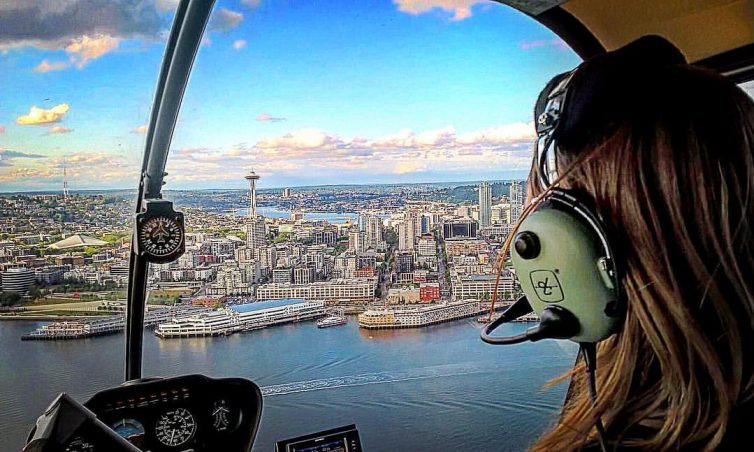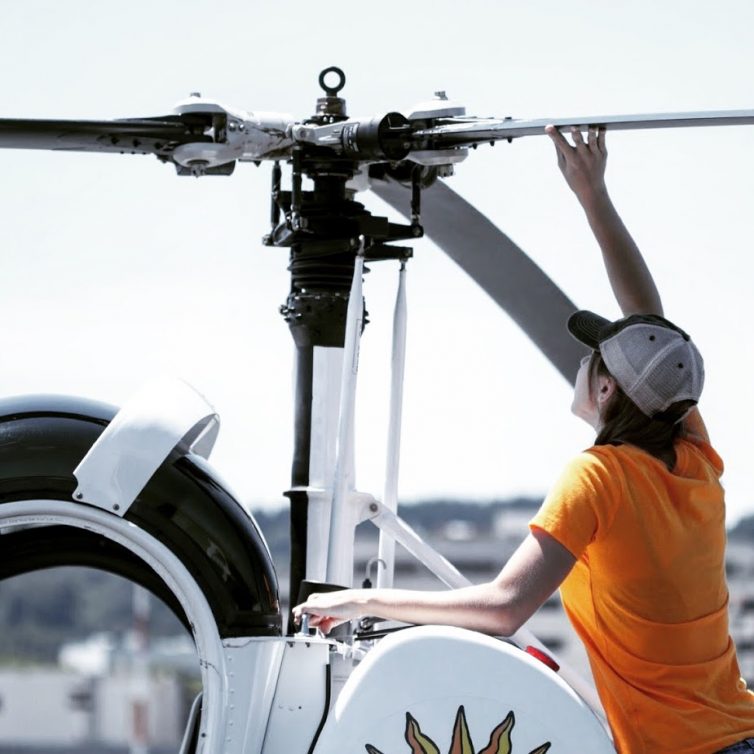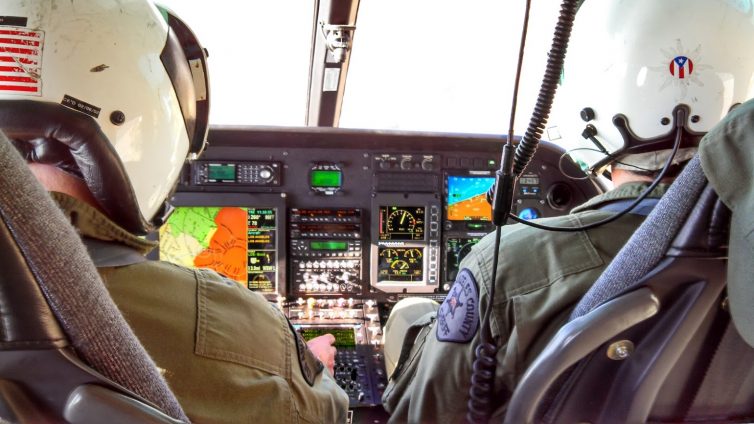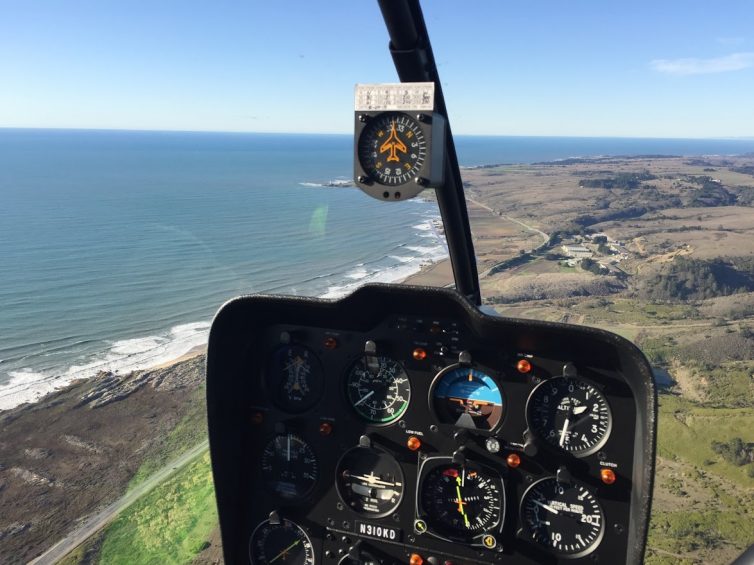
I am flying to downtown Seattle in an R44 – Photo: Kassy Coan
A few years ago, during my transition between software engineering at Google and program management at Microsoft, I took an intro flight in a Robinson 22 helicopter, simply because there was a good deal going, and it sounded like an adventure. I instantly fell in love with the challenge of flying, was mesmerized by the aerodynamics of it all, and was enthralled by the thought of how to improve the user experience of the pilot and optimize the process of flight.
Here I am, many years later, thinking that was the most expensive $70 Groupon I’ve ever come across! However, I’m now an FAA-rated private helicopter pilot, with 150+ total flight hours between the S300, R22, and R44, and have started working on my fixed wing add-on.
I’m often asked if I’ll ever take up piloting as a career. When I say this isn’t likely, but I plan to invest in it further as a hobby, the looks I get vary from ’œwhy are you wasting your time’ to ’œhow is it worth it financially?’ The same goes for anyone looking at my resume (or that of other aviators); those who haven’t experienced aviation training don’t immediately see how the skills it takes to fly an aircraft apply to improving various aspects of life and other non-aviation-related career skills.
Here are a few of the skills I gained while getting my private pilot license, which help me every day in my personal and professional life:

Kassy performing a pre-flight on an S300 helicopter – Photo: Sean Fujiwara
1. Planning for a dynamic environment of unknowns
When planning a flight, there are countless variables which must be considered, such as weather, winds, fuel burn rate, other air traffic, and technical or mechanical failures, just to name a few. What is interesting about this is that the environment we are planning for is not static; it’s changing. The weather at your destination will be different when you land than it was when you were planning the flight. The ship you flew last week may have a different fuel burn rate than this new one you are renting. It took you 15 gallons to make this trip last time, but now you have a 15-knot headwind – will you make it? Do you have enough fuel to turn around? The density altitude is a lot higher at this airport, so the performance of the ship won’t be what you’re used to; how will this affect your landing?
Alright, so you can plan a flight. How does this help you be in an office and launch web stuff?
When building products, we are in a very dynamic environment. In addition to our resources changing, the world and audience we are building for, and the products already available to them, changes as well. Some examples of these changes that I’ve experienced in my current career are members of the team leaving the project (when this happens, the project deadline doesn’t magically get extended, nor is there always someone to replace the team member), shifts in the market which change the company and team goals or priorities, and unanticipated project obstacles, such as compatibility or new requirements from the user.
2. Multi-tasking, context switching, and prioritization
There is so much going on while flying! In addition to actually flying the machine, you have to be on the communications, watching visuals in the field, navigating, consuming data inputs from the flight deck, checking that the information you get from the flight deck is accurate and that it makes sense with the other information available, making new plans and back-up plans based on the ever-changing situation/environment you are in, and dealing with other potential distractions, such as passengers.

The Los Angeles Sheriff’s Department uses a team of two pilots to help manage all of the data inputs and decision making that must be done while keeping the city safe – Photo: Kassy Coan
After dealing with all of that, there is no amount of things you can put on my plate that will push me over an edge. I train to deal with many things at once, with my life, and those of my passengers, depending on it. When it comes down to it, I always remember I have one main priority – keep flying the ship. I complete the primary goal and work on the others as resources allow. In my career, these same concepts are ingrained into my habits. When things get super stressful I come back to my main priority – the user and feature goals laid out at the beginning. While we may adapt these goals as the market shifts, they always exist. While this may sound like a simple concept, it’s a common flaw to get so caught up on the additional helpful tasks/features, such that we forget what our primary goals were – ultimately leading to never accomplishing the MVP, or minimal viable product we committed to creating and delivering to our customers.
3. Risk – It’s how you achieve great things, when you manage it properly.
No matter how much you train (or how excellent your school is), how well you pre-flight, the amount of sleep and nutrition you get, or the thoroughness of your planning and backup plans, there is risk involved when taking off and throughout the flight until the wheels are on the ground, key is out, and the blades stop turning. Risk will always exist, and as pilots we work to manage and mitigate this risk as much as possible. The only way to have zero risk is to never try and, well, that’s just failure.
However, no matter how much we mitigate, by nature of the job as a pilot, as you gain more experience, you take on more risk. When you start bringing passengers, you’re adding distractions. When you have advanced training, such as long-line or firefighting, it’s normal to advance in your career and do more risky things. Taking on more risk (in a responsible manner) equates to you achieving more – ultimately, literally saving lives.

Ferry flights, or jobs transporting ships long distances, are some of the most fun and beautiful jobs you can get. However, weather, recent maintenance, and other factors all add risk. – Photo: Kassy Coan
Somehow, this concept tends to get lost in the corporate world. We take on risk while we are new to the industry, try cutting-edge projects, we aren’t afraid to fail the first try (or first few tries), iterate, and learn. When in large companies, we start out managing and accepting risk, and this helps us achieve great things. We accomplish something no one has done before, and we do the everyday tasks in an innovative way. With this success comes larger teams, larger budgets, more to lose. The skill of managing risk becomes more necessary.
Conclusion
I’m glad I’ve built, and continue to build, this skill set in aviation. While I’m not in the air everyday (or even close to that), I do use the skills and knowledge everyday, multiple times a day, and I achieve greater things because of it. Aviation training not only keeps me safe in the air, but also keeps me pushing the boundaries of technology at my day job. Everyone, including the everyday office worker, could benefit from the skills developed by piloting.
I’m forwarding this to my wife – not that it’ll make that much of a difference (she STILL thinks my flying is “a hobby”) but I’m convinced I wouldn’t have landed my current job if I had not finished my PPL.
Hey Ray,
Let us know how that works out :).
David | AirlineReporter
Nice article Kassy Coan…Good luck with the fixed wing, although that should be easy for you!
Thanks! Time will tell.
Wow that is quite a refreshing thought to come across.
Thanks, Kassy for a well written and clearly thought-out piece attempting to explain the association of skills between assumed disparate applications. It is too bad that many do not consider or appreciate the ability for experiences to bleed into other areas. You do an excellent job here, but one thing I would add, is that individuals who are increasingly curious are always strong resources in the corporate world. Better yet, those who can describe why everything is applicable.
Cheers!
JL Johnson | AirlineReporter
Thanks, JL! I agree. Curiosity brings much added value and understanding to the day to day aspects and corporate projects. Thank you for the thoughts!
Nicely written Kassy.
I’m not a pilot (though some days I wish I was!) but my only comment on #3 is planning, in flying and business: when you fail to plan, you plan to fail. You can’t control every single contingency, but when you account for the most common and dangerous ones, the rest are easily surmountable.
Keep doing what you do! Looking forward to more.
hey i thought the earth was round. in this picture in the back ground looks pretty flat to me.
Excellent article, Kassy. Thanks for sharing. My son harbours helicopter pilot dreams and I’d also like to do something similar if I can get my wife to buy into the idea too! She’s nervous about the safety case.
Hi Alastair! I encourage you and your son to do a “demo” or “discovery” flight. These are typically really well priced (give or take some on $100 for an hour experience between ground and flight). This would be a great opportunity for you to learn about all the safety training that goes into flight.